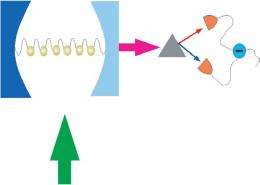April 8, 2009 feature
Entangled Light in Bose-Einstein Condensates

(�鶹��ԺOrg.com) -- When physicists entangle light, they usually use nonlinear crystals as the source. However, it’s difficult to control the entanglement generation process in a bulk crystal, and so scientists have been looking for a more fundamental source of entangled light. Now, they may have found a candidate: Bose-Einstein condensates.
�鶹��Ժicists Ho-Tsang Ng and Sougato Bose of the University College London have recently proposed a method to generate entangled light using a Bose-Einstein condensate trapped in an optical cavity. If the system works, it would enable researchers to control the degree of entanglement. Entangled light, which is regarded as the ideal entity for sharing entanglement between distant parties, has many future applications in quantum communications. Ng and Bose’s study is published in the New Journal of �鶹��Ժics.
“I would say that the significance of the work is two-fold: firstly, it provides an immediate application of a novel setup (namely the BEC in a cavity) that has been recently realized in experiments,” Bose told �鶹��ԺOrg.com. “Secondly, it is the application of a mesoscopic system to do something which is normally done using a macroscopic system such as a crystal.”
A Bose-Einstein condensate (BEC) is a group of atoms that are cooled to near absolute zero, which causes the atoms’ wavelengths to increase and overlap so that the group acts like a single atom. Although the atomic cluster has a relatively large size, it’s considered to be a single quantum state and it obeys quantum laws.
In their study, Ng and Bose propose trapping a BEC in an optical cavity, where the ultra-cold atoms are trapped in a periodic potential. This scheme ensures that every atom will experience exactly the same interaction with the light field, resulting in very strong atom-photon coupling. As the physicists note, strong atom-photon couplings are extremely useful for performing quantum information processing before decoherence sets in, which has the potential for applications such as long-lived quantum memory and quantum networks for light-matter interfaces.
In this case, the strong atom-photon coupling provides a method for realizing entangled light. In the configuration, a laser continuously emits pairs of photons of two different frequencies into the trapped BEC. Acting as a medium, the BEC mediates entanglement between the two photons’ cavity (light) modes. As the quantum-correlated light modes decay, they leak out of the cavity through a one-sided mirror.
“Each atom in the BEC, being in exactly the same wavefunction, will experience exactly the same light field,” Bose explained. “They will all thereby have precisely the same interaction with the light field, unlike the case for a thermal gas, for which different atoms will be in different velocities and positions and may interact differently with the light field. All the atoms will thus go on doing the same process, namely taking a photon from the laser and churning out two photons of different frequencies. This process makes the different frequencies of light quantum mechanically correlated or entangled.”
Since detecting light entanglement inside the cavity is very difficult (and not very useful, since the entangled modes should be well separated in space), the scientists explain that it’s necessary to detect entanglement in the light leaking out of the cavity. Outside of the cavity, a prism splits the leaked light into two different frequencies. Once separated, a homodyne detection measures and verifies the entanglement. The scientists expect that their proposal could be experimentally realized with current technology.
The main advantage of generating entangled light with a BEC compared with bulk crystals is the control offered by the BEC method. By adjusting the strength of the atom-photon couplings, Ng and Bose explain how to control the degree of entanglement: a large number of atoms and decreased cavity decay optimizes the entanglement.
“Potentially, here the degree of entanglement could be higher and it could be less noisy,” Bose said.
More information: Ng, H T and Bose, S. “Entangled light from Bose-Einstein condensates.” New Journal of �鶹��Ժics, 11 (2009) 043009.
• !
•
Copyright 2009 �鶹��ԺOrg.com.
All rights reserved. This material may not be published, broadcast, rewritten or redistributed in whole or part without the express written permission of �鶹��ԺOrg.com.


















